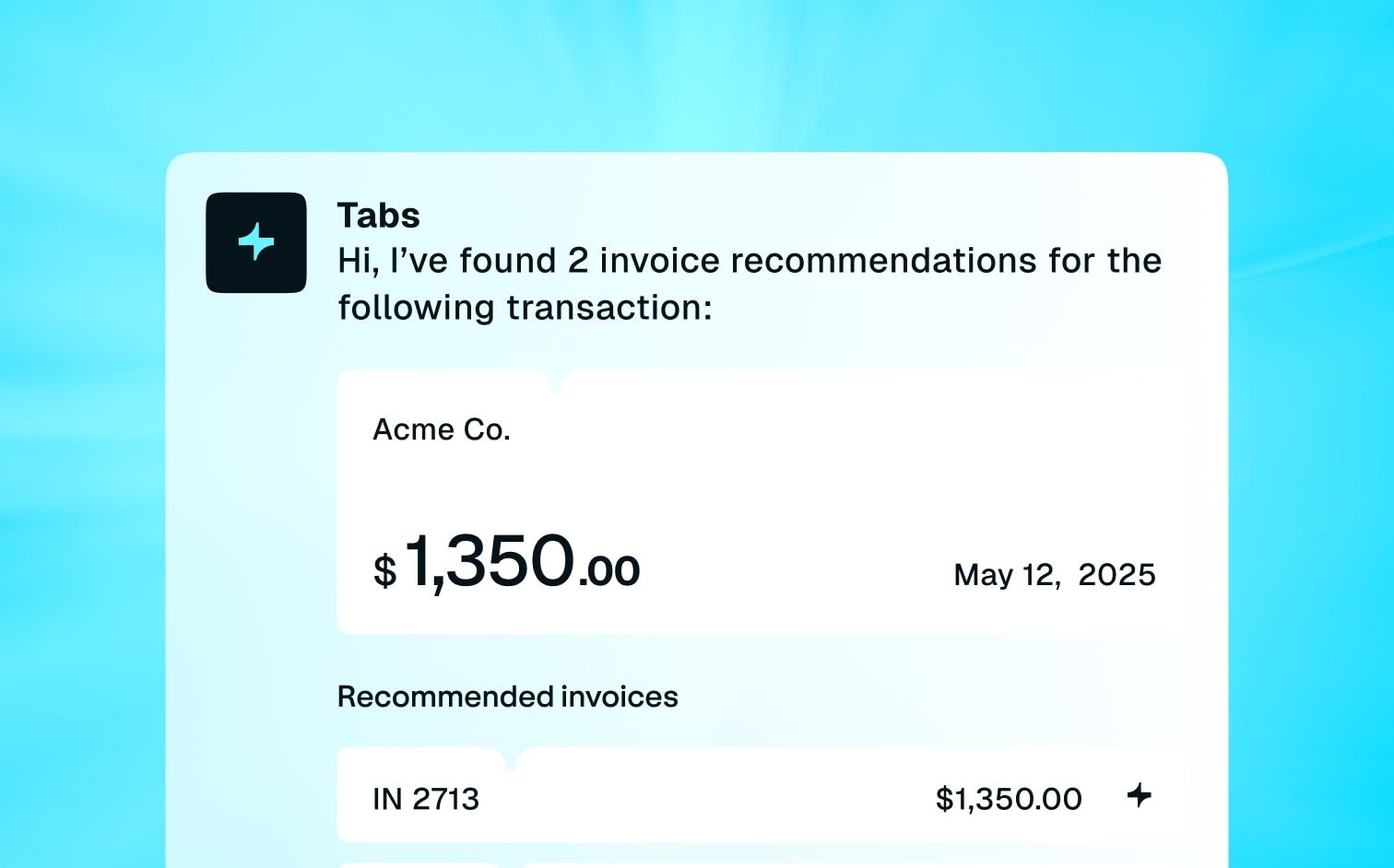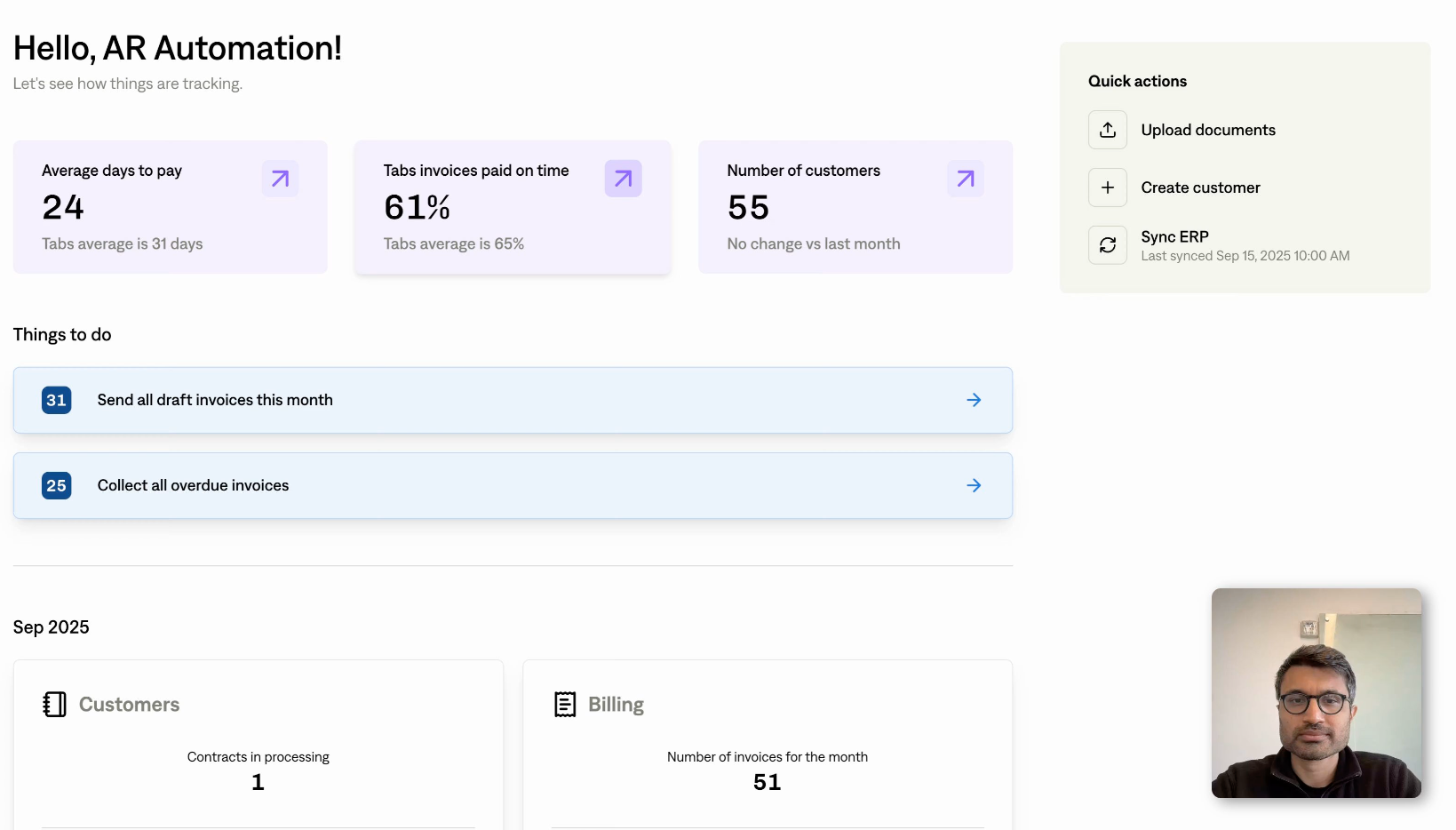Chasing down invoices is a drain on your time and resources. Strong accounts receivable management is crucial for any SaaS business. A proactive approach to AR lets you focus on what matters: growth. In this post, we'll cover five actionable strategies to transform your AR processes and free up your time. Let's get your cash flow flowing smoothly and build a stronger financial future for your business.
By exploring the following practical strategies, you can optimize your accounts receivable processes, boost financial health, and increase operational efficiency.
Streamline Your Accounts Receivable Management
Of course, optimizing your accounts receivable management means you’re focusing on more than cash flow improvement. You want to create a system that speeds up payment times and minimizes financial risk.
Start by integrating technology that automates invoicing and follow-up. Automation ensures accuracy and frees your team to focus on more strategic tasks rather than routine collection efforts. Tailor your communication strategies to each client’s specific needs and behaviors to improve responsiveness and payment times. By assessing the creditworthiness of new clients and establishing clear criteria for credit limits and terms, you reduce the risk of late payments.
This foundation sets the stage for the five detailed strategies discussed in the following sections, each aimed at enhancing a specific aspect of your accounts receivable process.
Key Takeaways
- Clear communication and automation are key: Well-defined payment terms and automated AR processes reduce errors and free up your team for more strategic work. This combination improves efficiency and client relationships, leading to timely payments.
- Assess clients and communicate proactively: Regularly evaluating client creditworthiness and maintaining open communication are essential for minimizing risk and building strong client relationships. Proactive follow-up ensures timely payments and fosters trust.
- Regularly review your AR processes: Consistent monitoring of key metrics like DSO, CEI, and ARTR helps identify areas for improvement and optimize your AR strategies. Regular reviews keep your processes efficient and aligned with your business goals.
What is Accounts Receivable (AR) Management?
Accounts receivable (AR) management is the process of tracking and managing money owed to your business by customers for products or services they've purchased on credit. Think of it as the system you use to ensure timely payment for your invoices. This includes everything from generating invoices and sending them out, to collecting payments and managing any late payments or disputes. Effective AR management is absolutely crucial for SaaS businesses, especially since recurring revenue and predictable cash flow are vital for growth and meeting financial obligations. A smooth AR process keeps your cash flow steady and predictable, giving you the financial stability to invest in new initiatives and scale your operations. For more information, check out this helpful resource on accounts receivable.
For SaaS companies relying on subscription models, healthy AR management minimizes the risk of bad debt and strengthens customer relationships. When you're consistently getting paid on time, you can focus on delivering excellent service and building long-term value for your customers. Plus, efficient AR management gives you a clearer picture of your financial health, allowing you to make informed decisions about your business strategy. By prioritizing AR, you're not just improving your bottom line—you're setting the stage for sustainable growth and success in the competitive SaaS landscape. Tools like Tabs' reporting features can help streamline this process and provide valuable insights into your financial performance. To learn more about minimizing financial risks, explore this resource on bad debt.
1. Crystal-Clear Payment Terms
Accounts receivable management begins with clear communication of payment terms and conditions. Setting these terms at the start of customer relationships lays the groundwork for timely payments and reduces the potential for misunderstandings.
Clear payment terms are not just administrative formalities. They’re also integral to securing your cash flow. You set expectations that align with your business’s financial planning by specifying when and how customers should make payments. Clear terms can avoid delayed payments and disputes, enhancing customer relationships by fostering trust and professionalism.
Drafting Effective Payment Terms
- Define Payment Timelines: Specify exact due dates for payments (e.g., within 30 days of invoice receipt) to avoid any confusion. Consider offering early payment incentives to encourage quicker settlements.
- Specify Accepted Payment Methods: Clearly state which forms of payment you accept (e.g., bank transfer, credit card, online payment platforms) and provide all necessary details to complete these transactions smoothly.
- Detail Late Payment Consequences: Outline the consequences of late payments, including any interest rates or fees. This helps with transparency and discourages delinquency.
- Don’t Forget to Customize for Client Needs: Tailor payment terms to fit different customer segments based on their payment history and creditworthiness. This flexibility can lead to better client relations and improved payment times.
Communicating Payment Terms Clearly
To communicate your payment terms clearly, embed them directly into contracts and invoices. This way, clients see these terms at every billing stage, and it reinforces their importance. Additionally, discussing payment terms verbally during onboarding strengthens a client’s understanding of the terms, allowing for immediate clarification of any questions.
This personal touch also builds client engagement. Sending regular reminders before payments are due keeps the terms at the top of your clients’ minds. These reminders should restate the due date and the amount due, maintaining consistent communication and underscoring the importance of timely payments.
Why Written Agreements Matter
Payment terms agreed upon in writing strengthen your and your client’s commitments. Written agreements serve as legal documentation that can be invaluable in disputes. They also ensure that every team member who interacts with clients understands the terms consistently, which maintains uniformity in how your business handles receivables.
2. Automate Your Accounts Receivable Process
Embracing digital transformation and automation is essential for modernizing accounts receivable management. This section explores the array of digital tools and automated processes that can enhance efficiency, reduce errors, and free up your team to focus on higher-value activities.
Automation transforms traditional, labor-intensive accounts receivable tasks by streamlining operations and minimizing human error. By automating routine tasks such as invoicing, payment tracking, and reminders, you speed up the process and ensure accuracy and consistency across all transactions.
Essential AR Automation Technologies
- Automated Invoicing Systems: Tools like electronic invoicing software automatically create and send invoices immediately upon delivery of goods or services. These systems can integrate with your sales and order processing systems to ensure that invoices are accurate and dispatched without delay.
- Online Payment Gateways: Using online payment systems lets you offer clients easy and secure ways to pay their invoices online. These platforms often provide options for credit cards, bank transfers, and other digital payment methods, facilitating quicker payments.
- Payment Tracking and Reconciliation Software: Advanced software can track incoming payments and automatically reconcile them with the corresponding invoices. This eliminates the need to manually match payments to invoices, saving time and reducing the likelihood of errors.
- Automated Reminder Systems: These systems automatically send payment reminders to clients before and after the invoice due date. This helps maintain a steady flow of payments and reduces the time spent chasing overdue accounts.
Implementing AR Automation
To start automating your accounts receivable process, first evaluate your current operations to find areas that would benefit most from automation. Look for tasks that consume a lot of time or are prone to errors, such as data entry and invoice tracking.
After identifying these areas, choose software that integrates seamlessly with your existing systems and meets your specific needs. Next, train your financial team to use the new tools effectively. Proper training ensures they can fully use the features of the automation software without disrupting daily operations.
Continuously monitor the performance of these automated systems to make sure they are meeting your needs. Regularly adjust your settings or processes to help maximize benefits and keep your operations running smoothly.
Tabs Simplifies Recurring Billing
For SaaS businesses, managing recurring billing efficiently is crucial for predictable revenue. Automated billing software like Tabs streamlines the entire subscription lifecycle, from initial signup to recurring invoices and payments. By automating these often complex processes, Tabs reduces manual effort, minimizes errors, and improves the customer experience. Features like automated invoicing, flexible payment options, and automated revenue recognition ensure accurate and timely billing, freeing up your team to focus on growth and customer relationships. Tabs gives you greater control over your recurring revenue and improves overall financial visibility.
3. Smart Financial Checks and Client Assessments
Conducting rigorous financial checks and assessing your clients’ financial health are crucial steps before extending credit. These measures protect your business from potential bad debts and help maintain a healthy cash flow. This section delves into implementing these practices and continuously monitoring your clients’ financial stability.
Credit checks and financial assessments help you understand the creditworthiness of your clients. These evaluations help you gauge the risk of offering credit and enable you to make informed decisions. By thoroughly assessing a client’s financial health, you can tailor credit terms that mitigate risk while accommodating client needs.
Setting Up Effective Credit Checks
- Establish Clear Credit Assessment Criteria: Define specific criteria for evaluating the creditworthiness of new and existing clients. This might include reviewing their credit score, financial history, and payment behaviors with other vendors.
- Use Credit Reporting Agencies: Leverage services from reputable credit reporting agencies to obtain detailed and accurate financial reports on your clients. These reports can provide insights into a client’s economic stability, past bankruptcies, and payment history.
- Develop a Standard Procedure for All Clients: Apply the same rigorous standards to all clients to maintain fairness and prevent potential biases. Standardizing your approach also simplifies the assessment process for your team.
Regularly Review Credit Terms
As you grow, regularly update your client credit files with the latest data and interactions to stay informed about any changes in their financial situation that could impact credit terms. Establish a schedule for reviewing the credit status of all clients periodically, such as annually or semiannually, depending on the credit size and associated risks.
You’ll want to adjust credit terms based on these reviews to reflect changes in a client’s financial condition. Consider offering more favorable credit terms if a client’s monetary health improves. Conversely, tighten the terms if their financial stability declines to reduce potential risks.
This proactive approach helps balance supporting client growth and safeguarding your business’s financial interests.
The Importance of Financial Checks
- Minimize Financial Risk: By conducting thorough credit checks, you significantly reduce the likelihood of extending credit to clients who cannot fulfill their payment obligations.
- Build Trustworthy Client Relationships: Transparent and fair credit practices create trust and reliability between you and your clients, leading to more stable and long-term business relationships.
- Enhance Cash Flow Management: With reduced risk of default and tailored credit terms, your business can achieve a more predictable and steady cash flow.
4. Proactive Communication for Faster Payments
Continuing open lines of communication with your clients is essential for effective accounts receivable management. Open and consistent communication with clients about their accounts establishes a transparent and trusting relationship, which helps prevent misunderstandings and delays in payment. Regular communication also allows you to address any issues or concerns that may arise, potentially impacting the payment process.
This section explores how to preserve communication channels and implement strategies that prompt timely payments.
Effective Communication Channels for AR
To establish productive communication channels, start by selecting the appropriate tools for your needs. Use a mix of emails, phone calls, and a dedicated client portal that allows clients to view payment histories and pending invoices.
Tailor your communication to suit each client’s preferences and history. For instance, some may prefer emails, while others might respond better to phone calls or text messages. And, of course, always aim for clear and concise messaging to avoid misunderstandings and ensure that your communications clearly state their purpose, whether it’s a payment reminder, an invoice clarification, or a discussion about payment terms.
Proven Follow-Up Strategies
- Timing of Reminders: Send initial reminders a few days before an invoice is due and follow up more frequently as the due date approaches and passes. Establishing a systematic approach to sending reminders reinforces the seriousness with which you treat the payment schedule.
- Frequency of Communication: The frequency of follow-ups should increase if a payment is overdue. Start with gentle reminders but escalate to more direct and frequent communications if the payment delay continues. However, keep the tone professional and courteous throughout.
- Use of Personalized Communications: Personalizing reminders can significantly increase response rates. Reference previous communications or discussions and mention any specifics about the services or products provided. This personalizes the interaction and reminds the client of the value they are receiving.
- Implementing Automated Reminder Systems: Automated systems can help manage the timing and frequency of reminders. You can set up these systems to send out reminders at predetermined times and customize the system to escalate the reminders based on the overdue time.
Tech Tools for Follow-Up
Technology significantly enhances the effectiveness of your communication. Integrate your communication tools with customer relationship management systems to gain insights into client behaviors and preferences, allowing you to customize your follow-up strategies more effectively.
Additionally, keep track of all interactions with clients regarding payments. This historical data is crucial for analyzing which communication strategies are most valuable with different clients, enabling continuous refinement of your tactics.
5. Regularly Review Your AR Practices
Regularly reviewing and adjusting your accounts receivable (AR) practices is critical to ensure they remain functional and aligned with your business goals. This ongoing evaluation helps identify bottlenecks and areas for improvement, keeping your operations agile and responsive. This section will guide you in systematically reviewing your AR processes and using key performance indicators (KPIs) to drive strategic adjustments.
Continuously analyzing your AR processes allows you to adapt to changes in the market environment, customer behaviors, and your business operations. Regular reviews help pinpoint inefficiencies that can slow your cash flow and impact your financial health. They also provide an opportunity to enhance the customer experience by streamlining payment processes, ultimately improving customer satisfaction and retention.
Key AR Performance Indicators
- Days Sales Outstanding (DSO): DSO measures the average number of days it takes to collect payment after you have made a sale. A lower DSO indicates that your company collects payments more efficiently, which is crucial for improving cash flow.
- Collection Effectiveness Index (CEI): CEI assesses the effectiveness of your credit and collection efforts over a given period, comparing the amount of credit extended to what was actually collected. This metric helps measure the success of your collection strategies and can indicate when a change in tactics is necessary.
- Aging Schedule: This breaks down receivable balances according to the length of time an invoice has been outstanding. Monitoring this can help you identify trends in late payments and focus your collection efforts on the most overdue accounts.
Days Sales Outstanding (DSO)
Days Sales Outstanding (DSO) gives you a snapshot of how long it takes, on average, to collect payments after a sale. A lower DSO is the goal—it shows you’re collecting payments efficiently and keeping cash flowing. For example, a DSO of 15 means it takes roughly two weeks to get paid, while a DSO of 45 means it’s closer to a month and a half. Keeping a close eye on your DSO helps you spot potential cash flow problems early on. If your DSO starts creeping up, it might be time to revisit your payment terms or communication strategies. For more information on calculating and interpreting DSO, check out this helpful guide.
Collection Effectiveness Index (CEI)
The Collection Effectiveness Index (CEI) measures how well your collection strategies are working. It essentially compares the amount of credit you extended to how much you actually collected over a specific period. A higher CEI (ideally above 80%) indicates that your collection efforts are on point. A lower CEI suggests you might need to adjust your client assessment process or get more proactive with follow-up communication. Tracking your CEI helps you fine-tune your approach and ensure you’re getting paid what you’re owed. You can learn more about CEI and other key metrics in this accounts receivable management guide.
Accounts Receivable Turnover Ratio (ARTR)
The Accounts Receivable Turnover Ratio (ARTR) tells you how many times, on average, you collect your receivables over a given period (usually a year). A higher ARTR generally means you’re doing a good job of collecting payments quickly. This metric, combined with DSO and CEI, gives you a comprehensive view of your collections performance. If your ARTR is low, it could signal underlying issues with your invoicing process or credit policies. Regularly monitoring your ARTR can help you identify areas for improvement and optimize your overall accounts receivable management. This resource offers a deeper dive into ARTR and its significance.
Conducting Effective AR Reviews
To conduct effective reviews of your AR processes, you’ll want to establish a regular review schedule that aligns with your business needs —monthly, quarterly, or annually. Regular reviews help capture trends and facilitate informed decision-making.
You can enhance these reviews by leveraging data analytics tools, which provide deeper insights into your AR performance and reveal patterns affecting cash flow. Additionally, it’s best to involve cross-functional teams in the review process, including members from sales, customer service, and finance. This diversity of perspectives can help identify issues and opportunities that might not be apparent from a single department’s viewpoint.
Improving AR with Feedback
Act on the feedback received from your team and customers to refine your AR processes. Consistent feedback on a specific aspect of your billing or payment process indicates that it requires attention. Implement any changes gradually to avoid disrupting existing operations while monitoring their effects.
Finally, track improvements over time by analyzing their impact on KPIs. This tracking helps determine the effectiveness of the changes and whether further adjustments are necessary so that you can guarantee continuous optimization of your AR practices.
Next Steps for Your Accounts Receivable
In today’s fast-paced market, staying ahead means constantly assessing and refining your approaches.
Integrating the strategies is not just about improving your financial health, but about enhancing overall efficiency. Effective accounts receivable management is fundamental to supporting a steady cash flow, reducing financial risk, and fostering strong customer relationships. By adopting the five strategies above, you position your business for success and resilience.
Take the first step toward optimizing your financial operations by reviewing your current accounts receivable practices. Tabs can assist you in automating and streamlining these processes, ensuring you meet and exceed your business objectives. Schedule a demo to learn more about how Tabs can transform your AR management and create a healthier cash flow.
Leveraging AR Management Software for SaaS Businesses
For SaaS businesses, using AR management software offers significant advantages. These platforms automate key processes, from generating invoices and tracking payments to sending timely reminders. This automation not only saves time and reduces errors, ensuring accurate financial data, but also frees up your team to focus on strategic activities like customer relationship management and revenue growth. No more getting bogged down in manual tasks.
Many AR management platforms seamlessly integrate with other financial systems, such as your CRM and accounting software. This integration streamlines data flow, eliminates manual data entry, and provides a holistic view of your financial operations. Integrating with your CRM can provide valuable customer insights, enabling you to tailor payment terms and communication strategies. Similarly, integration with your accounting software ensures accurate revenue recognition and simplifies financial reporting. For more robust reporting, Tabs offers features that provide key metrics for finance teams, further enhancing your financial management capabilities.
Challenges of AR Management in the SaaS Industry
The SaaS industry presents unique challenges for AR management. Recurring subscriptions, upgrades, downgrades, and failed payments require specialized handling. Managing recurring payments efficiently is crucial for maintaining a predictable revenue stream. Automating complex invoicing with software like Tabs simplifies this process, ensuring timely and accurate billing for each subscription cycle. Plus, Tabs supports various payment types, providing flexibility for your customers and streamlining your payment collections.
Handling upgrades and downgrades effectively is another key challenge. AR management software can automate these subscription changes, ensuring accurate billing. Addressing failed payments promptly and efficiently is also essential. Automated dunning management features within AR software can help recover lost revenue by automatically retrying failed payments and sending personalized reminders. Open communication with customers is key to resolving payment issues and maintaining positive relationships. By simplifying revenue recognition, Tabs helps SaaS businesses accurately track and report their recurring revenue, further addressing the complexities of AR management in the subscription economy. See how Tabs extracts key contract terms with AI to further streamline your billing processes.
Related Articles
- Receivables Management: A Practical Guide for SaaS
- Accounts Receivable Process: A Practical SaaS Guide
- Accounts Receivable Automation: Benefits & Implementation
- AR Automation: Streamline Billing and Boost Efficiency
- Managing Operating Expenses for Business Growth
Frequently Asked Questions
How can my SaaS business benefit from strong accounts receivable management? Well-managed accounts receivable directly impacts your cash flow, allowing you to reinvest in your business, cover expenses, and scale operations. It also strengthens customer relationships by ensuring transparent and predictable billing, leading to increased customer satisfaction and retention. A healthy AR system provides a clear financial picture, enabling data-driven decisions for future growth.
What are the initial steps to improving my AR processes? Start by clearly defining your payment terms, outlining accepted methods, timelines, and late payment consequences. Then, evaluate which parts of your current process can be automated, such as invoicing and payment reminders. Finally, implement a system for assessing client creditworthiness to minimize financial risk.
What key metrics should I track to assess the health of my accounts receivable? Days Sales Outstanding (DSO) helps you understand how quickly you're collecting payments. The Collection Effectiveness Index (CEI) measures how effective your collection efforts are. Finally, the Accounts Receivable Turnover Ratio (ARTR) shows how efficiently you're converting receivables into cash. Monitoring these metrics helps identify areas for improvement and track progress over time.
What role does technology play in modernizing AR management? Technology is essential for streamlining AR. Automated invoicing systems eliminate manual errors and ensure timely delivery. Online payment gateways offer convenient payment options for clients, accelerating the payment cycle. Automated reminders reduce the need for manual follow-up, freeing your team for more strategic tasks. Integrated platforms provide a holistic view of your financial operations, improving efficiency and decision-making.
How can I ensure consistent improvement in my AR processes? Regularly review your AR practices, analyzing key metrics and gathering feedback from both your team and your clients. Use this information to identify bottlenecks and areas for improvement. Implement changes strategically, monitor their impact, and continue refining your approach to maintain a healthy and efficient AR system.





